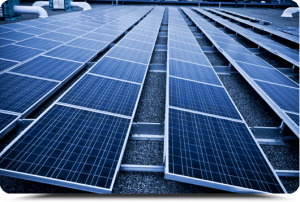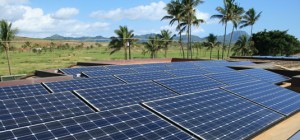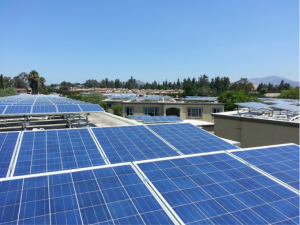/cdn.vox-cdn.com/uploads/chorus_image/image/55614127/rooftop_solar.0.jpg)
California regulators are in the process of revising the state’s incentives for rooftop solar installations and other small-scale renewables. The current incentives, known as “net energy metering,” compensate local producers for surplus energy fed back into the grid with a full retail credit, rather than a less-expensive wholesale or “avoided cost” rate.
Ratepayer advocates believe this full retail credit is a subsidy for wealthy homeowners who disproportionately have rooftop solar, while some environmental and solar groups argue they are a necessary tool to achieve California’s ambitious climate agenda and promote economic growth.
We’ll hear a debate tonight on the state’s approach to subsidizing this type of renewable energy tonight on State of the Bay at 6pm PT. Joining us will be:
- Severin Borenstein, Director of the Energy Institute at Haas School of Business
- Loretta Lynch, former President of the California Public Utilities Commission
Plus, as the Bay Area starts to emerge from the pandemic, will hunger finally subside? Tanis Crosby, Executive Director of the San Francisco Marin Food Bank, we’ll give us the latest.
And finally, we’ll hear from State of the Bay frequent contributor Lara Bazelon, Director of the Criminal and Juvenile Justice and Racial Justice Clinics at the University of San Francisco School of Law, about her new novel, “A Good Mother.”
Tune in tonight at 6pm PT on KALW 91.7 FM in the San Francisco Bay Area or stream live. Call 866-798-TALK with questions during the show!
Energy economists don’t like rooftop solar. Depending on the policy involved, it can entail significant and cost-inefficient ratepayer subsidies. For example, Lucas Davis at UC Berkeley’s Energy Institute at Haas recently calculated that non-rooftop solar customers are paying $65 per year to subsidize solar customers. He got this number by taking the difference in price between a retail credit for every kilowatt hour delivered from a rooftop solar customer to the grid and the wholesale price that this electricity actually costs.
In California, the average retail electricity price is about $0.18/kWh, while wholesale rates are close to $.04/kWh. That means that utilities are losing about $.14/kWh for each retail credit they give rooftop solar customers for their surplus solar (since they could have purchased the electricity for much cheaper elsewhere). And since utilities have a lot of fixed costs sunk in grid infrastructure, Davis was able to calculate the total subsidized amount spread over non-rooftop solar customers and divide it by ratepayers to arrive at the $65 per year in ratepayer cost-shifting.
Ultimately, it’s that cost-shifting that explains why energy economists like Davis and Serverin Borenstein hate California’s new solar rooftop mandate so much.
But this cost-shifting doesn’t have to happen — it’s due specifically to electricity rate policies. And in that respect, Hawaii tells a different and more promising story. Ultimately, I believe that state’s rooftop solar policies are where California is headed soon.
In Hawaii, utilities stopped offering full retail credit for surplus rooftop solar back in 2015. Instead, they essentially pay solar customers the wholesale rate for their surplus. As a result, utilities aren’t losing what would be $.14/kWh in California for each retail credit they give. So no cost-shifting happens.
And the impact on the ground for Hawaii rooftop solar customers? Homeowners are still ordering solar panels, but now home battery installations are starting to take off, too, as this state government chart from Utility Dive shows:

To be sure, it’s still relatively early days of the policy and the on-the-ground response. But given plunging battery prices, as well as cheaper solar installations, this solar-plus-battery technology solution seems like a great way to address complaints about cost-shifting and ratepayer subsidies. It also points to a path forward for the rest of the country, with a future of rooftop solar on most homes — and batteries in every basement or garage.
The upside is more clean technology deployed, a bigger market to bring down costs further on solar and home energy storage, reduced greenhouse gas emissions, and improved grid resilience in the case of extreme weather or other disasters. Not a bad deal all around, and one California will probably eventually see as well, as its rooftop solar policies evolve.
As I blogged about yesterday, the California Energy Commission unanimously approved a new solar mandate for all new residential construction in the year 2020. I spoke to KPCC radio in Los Angeles and Reuters about the decision.
While I think the mandate is sound economically and environmentally, Severin Borenstein at UC Berkeley takes a contrary view on the economics. Severin doesn’t like rooftop solar in general, as opposed to more cost-efficient utility-scale solar, and he foresees problems with ratepayers subsidizing the installations.
For my part, I think it’s clear the state is heading away from the retail credit model of subsidizing excess solar production, which Severin doesn’t like. Instead, state regulators will likely to move to paying the wholesale rate for surplus solar from rooftops, as Hawaii basically now does. So new batteries will likely accompany these home solar installations, because they will be an economically sound technology to capture surplus solar rather than feed it to the grid for a relatively puny wholesale rate. That’s what we see consumers doing in Hawaii in response to the loss of retail credit.
And in that respect, the new commission rules could help, as they also give batteries “compliance credits” to reduce the size of the needed solar system. They also include incentives to move away from natural gas to new homes, as well as other efficiency measures.
Once again, California is taking a strong leadership position on the environment that will benefit clean tech deployment and save new homebuyers money in the process. The decision should be a major boost for these needed technologies.
The California Energy Commission is the state agency responsible for developing and enforcing energy efficiency standards for new buildings. The result of these stringent codes, starting in the 1970s, has been higher construction costs but saved energy bills and pollution overall.
Now the commission is poised to vote today on a significant new mandate: rooftop solar on all new all new single-family houses built after January 1, 2020, as well as new multifamily buildings up to three stories tall.
As the San Francisco Chronicle reported:
Together with tough new efficiency standards for windows and insulation that the commission will consider Wednesday, the solar mandate could add $10,538 to the cost of building a house, by the agency’s own estimate. The extra expense would hit at a time when California is suffering a severe and deepening housing affordability crisis.
The move’s supporters insist the solar homes would save their owners money by slashing monthly utility bills. That savings could be worth $16,251 over the 30-year life of the house, according to the commission.
The commission took years to develop this proposal and studied the costs and benefits carefully. The agency commissioned a detailed study last year summarizing these findings, which showed the benefits of the policy exceed the costs in every climate zone in the state.
Meanwhile, for developers who don’t like the added cost of the panels to the construction bill, it’s worth noting that a Lawrence Berkeley National Laboratory study from 2015 found that prospective home buyers place a $15,000 average premium on homes with solar compared to similarly situated homes without. This premium would more than compensate developers for the increased construction costs, as homebuyers properly value the utility savings going forward.
In the long run, the move may force the California Public Utilities Commission to scale back incentives for rooftop solar from the current arrangement of giving retail credit to homeowners for their surplus power generation. With every new home having solar, the policy won’t be financially sustainable going forward.
But for now, the upside of a mandate would be a huge boon for the solar industry, as well as significant greenhouse gas emission savings from reduced energy demand from the residential sector. It would also be a powerful statement on climate change and clean energy from the fifth-largest economy in the world, as well as a big boost for renewable energy generally.
Most electric utilities hate rooftop solar. When a customer installs solar on their roof, it means fewer sales (and therefore revenue) for the utility. It also means more unpredictable and dispersed sources of power from rooftops everywhere. As a result, many utilities across the country have been trying to kill state rooftop solar incentives for years.
 I’ve covered the battles in states like California, Hawaii and Nevada on this blog. The short of it is that California has slightly decreased their incentives for rooftop solar, in the face of declining prices and concern about utility costs; Hawaii has retrenched significantly but in turn created a new market for home batteries + solar; and Nevada brutally ended their incentives a year ago, leaving even existing solar customers without incentives that they had relied on when they bought their panels.
I’ve covered the battles in states like California, Hawaii and Nevada on this blog. The short of it is that California has slightly decreased their incentives for rooftop solar, in the face of declining prices and concern about utility costs; Hawaii has retrenched significantly but in turn created a new market for home batteries + solar; and Nevada brutally ended their incentives a year ago, leaving even existing solar customers without incentives that they had relied on when they bought their panels.
But the end of 2016 brought some significant updates for Nevada and now a new state, Arizona. First, as Greentech Media reported, Nevada regulators have restored the incentives for customers in the northern utility service territory (after having previously given into public pressure and restored the incentives for existing customers to “grandfather” them in).
But Arizona regulators have decided to jump off the rooftop solar cliff, killing existing incentives (which involve a full retail credit for every surplus kilowatt of electricity generated by the panels and not used on-site). Instead, solar customers in Arizona will be eligible for a vastly reduced and unpredictable “export rate” for any surplus electricity generated. As the Arizona Daily Star described:
The export rates will be determined in each utility rate case and will initially be based on a “resource comparison proxy” based on a weighted, five-year average cost of power from utility-scale solar farms.
The new export rates will vary by utility and be stepped down annually, in increments limited to 10 percent each year.
Solar industry advocates are already predicting that their industry will die in Arizona, as they correctly predicted would happen in Nevada after incentives were killed there, too.
Once those jobs disappear and Arizonans realize what they’ve lost, especially given that the state was otherwise one of the best-selling markets for solar with its abundant sunshine and high air conditioning bills, expect major political pushback. I wouldn’t be surprised if we see a Nevada-like reversal in the coming year or so.
In the meantime, the big winner could be battery companies like Tesla. Per Bloomberg, as the company “flipped the switch” yesterday on its gigafactory in Nevada, it will potentially have a new market to sell its product.
Why? Because if solar customers in Arizona aren’t going to get paid much for their surplus energy anymore, they’ll be interested in a cheap battery that can store that surplus and help them use all of it on-site. The battery therefore allows them to effectively recreate that full retail credit they used to get under the old system: any electricity they would have had to purchase from the utility when the panels weren’t producing or producing enough, they can now get from their battery.
So while states lurch around on their rooftop solar policies, the long-term trend seems clear: the incentives are decreasing, and cheaper batteries will be filling that void.
On Friday, Elon Musk unveiled a way to make solar panels as sleek and cool as Tesla has made electric cars. You can watch the video above, but it’s hard not to feel like this is the future of solar panels. The panels are broken down into tiles that (according to the video and photos) look pretty much exactly like real roofing material. According to Musk, they are also supposedly sturdier than everyday roofing material. In short, there’s no negative aesthetic impact from the panels, while you get a better roof in the process.
 You can see photos here from Tech Crunch. And here’s the slate tile model, in the photo on the right. As you can see, it’s hard to tell that there’s any solar PV modules in there. It looks “real.”
You can see photos here from Tech Crunch. And here’s the slate tile model, in the photo on the right. As you can see, it’s hard to tell that there’s any solar PV modules in there. It looks “real.”
Musk made a point to say that the cost of the solar roof is less than the cost of a new roof plus electricity. That could be the case, but right now we don’t have any cost figures on the solar roof. We also know that the solar roof panels are not as efficient as regular solar panels (as the Tech Crunch article points out), and presumably any homeowner would be paying for panels in inefficient (i.e. shaded) parts of the roof. Plus, they wouldn’t be sized to the demand on-site, so customers may be paying for too much solar production compared to the retail credit they can get to offset their usage.
And of course, how many people are replacing their roofs in any given year? If the average roof lasts 25 years, that means just 4% of the market, and probably less given that many people are renting or living in multi-unit dwellings without access to their roof.
But Musk knows that the incentives around rooftop solar are diminishing across the country. As his PowerWall battery gets cheaper, solar customers are going to want to bundle solar with storage, effectively making any utility credit system pointless. After all, why be dependent on regulators giving you retail credit for any surplus solar you generate, when you can just use all your solar energy on-site as you store it for nighttime and cloudy days in your battery?
So lots of unanswered questions, but one thing is clear: solar panels just became sleek and cool — something you couldn’t necessarily say before Friday.
Nevada and Hawaii are two states that have taken different, though both scaled-back, approaches to rooftop solar. But the good news for solar advocates is that both states appear to be making progress, for different reasons.
 First, Hawaii. The Aloha State retrenched from the generous net metering retail rate compensation last year. Instead, state regulators pushed a hybrid option that allows customers to either take a wholesale rate for all power they export or get a retail credit for all the power they use on-site (but not for any exports, which are not credited).
First, Hawaii. The Aloha State retrenched from the generous net metering retail rate compensation last year. Instead, state regulators pushed a hybrid option that allows customers to either take a wholesale rate for all power they export or get a retail credit for all the power they use on-site (but not for any exports, which are not credited).
And in a positive development, the new rates are actually leading to enough customer demand that the state may soon reach its cap on new enrollees. As Utility Dive reports, the cap may be met as soon as next month. What that means is that the economics of the reduced incentives are still working for many customers, and it also gives them an incentive to buy a battery, if they go with the retail rate (in order to maximize their on-site usage).
Granted, Hawaii uniquely has ridiculously high electricity rates and tremendous solar exposure, making it not exactly representative. Still, it shows that the economics of reduced incentives can still work, once the price of the panels comes down (or the price of electricity increases).
 Meanwhile, over in Nevada, the state gutted its solar incentives, even going back on its deal with existing customers, leading to stranded assets and betrayed buyers. But now an electoral push may reverse this decision by voter initiative. The utility is fighting back, per the Las Vegas Review-Journal, but so are solar companies. And there are murmurs that the governor is willing to hash out a deal with the solar companies.
Meanwhile, over in Nevada, the state gutted its solar incentives, even going back on its deal with existing customers, leading to stranded assets and betrayed buyers. But now an electoral push may reverse this decision by voter initiative. The utility is fighting back, per the Las Vegas Review-Journal, but so are solar companies. And there are murmurs that the governor is willing to hash out a deal with the solar companies.
My guess is that Nevada will end up with a compromise, perhaps along the lines of the Hawaii path. And in the long run, we know the current generous net metering incentives won’t last forever. So a future that still encourages deployment and also on-site storage in the form of batteries would be a good one.
In the very long term, rooftop generation may not be the best way forward anyway, particularly given that many people don’t have a rooftop with sun exposure or lack sole access to theirs. So we should be simultaneously encouraging more community solar and microgrids as the best way to decarbonize and localize our electricity systems, leading to greater reliability and cheaper prices in the process.
 Another Aloha Friday from our friends in Hawaii, where record-setting rooftop solar deployment on the island of Molokai is leading to an avoidable and largely policy-made crisis. As the Molokai Dispatch reports:
Another Aloha Friday from our friends in Hawaii, where record-setting rooftop solar deployment on the island of Molokai is leading to an avoidable and largely policy-made crisis. As the Molokai Dispatch reports:
As of last March, 65 solar applications on Molokai were in limbo, following an effective shut-down of Maui Electric to accept additional rooftop solar systems onto the island’s grid. At 51 percent as of last year, Molokai has the highest percentage in Hawaii of rooftop solar compared to the island’s peak electricity demand. Most of the rooftop solar is installed under a program called Net Energy Metering (NEM), which pays customers the retail electric rate for excess energy generated from their panels. Maui Electric asked the PUC to close that program, and their request is still being reviewed.
During a meeting on Molokai in March 2015, Mat McNeff, MECO manager of engineering, told residents because the high volume of solar generation on Molokai could cause fluctuations in electric frequency resulting in potential island-wide power outages, MECO is no longer able to connect new rooftop photovoltaic (PV) systems under the NEM program.
I’m sympathetic to the challenges that this level of solar penetration can cause for grid operators. But there should be a logical and immediate policy response to address the challenges.
First, the utility needs to get permission immediately to revise electricity rates to encourage as much usage as possible during peak solar hours. State regulators should require these time-of-use rates to get island residents to shift as much discretionary usage to mid-day hours and away from night time as possible. I recognize there may be some equity impacts for those unable to shift their usage, but think of the equity impacts right now from holding up all of these solar applications.
Second, state regulators need to develop an immediate incentive program for those with solar applications to also purchase on-site energy storage. Home batteries could help moderate the output from this rooftop energy and provide electricity after the sun goes down. This would greatly help grid operators deal with the frequency fluctuation and avoid having to ramp up other resources quickly around sunset.
While it’s a bit unfair to require this only of new solar customers, it’s a long-term and unavoidable need and better than letting them languish. Plus the incentives could also target existing solar customers.
To be sure, these policy responses aren’t exactly new ideas. They are commonly discussed throughout the U.S. and other places with strong solar policies as long-term needs to deal with increasing solar uptake. But the island of Molokai is experiencing a solar crisis right now, and it’s small enough to implement these ideas quickly and see how they play out.
I hope the utility and state regulators can move quickly to address this problem. The rest of the world will certainly be watching.
The New York Times ran an excellent piece over the weekend on the challenges in Hawaii to adding more rooftop solar. Hawaii’s investor-owned utility has been restricting new access to rooftop solar compensation for the last 18 months. Utility spokespeople claim it’s due to the high volume of solar rooftops in the state, which leads the nation. They say it’s creating operational expenses and reliability challenges. But the reality is that utility leaders simply don’t want to lose revenue from more distributed solar.
As the article points out, Hawaii is presenting a glimpse of our future across the U.S., as solar panels become cheaper and electricity rates increase. But I was struck by one part of the story, detailing how some customers are reacting to these restrictive policies:
Installers — who saw their fast-growing businesses slow to a trickle — are also frustrated with the pace. For those who can afford it, said James Whitcomb, chief executive of Haleakala Solar, which he started in 1977, the answer may lie in a more radical solution: Avoid the utility and its grid altogether.
Customers are increasingly asking about the batteries that he often puts in along with the solar panels, allowing them to store the power they generate during the day for use at night. It is more expensive, but it breaks consumer reliance on the utility’s network of power lines.
“I’ve actually taken people right off the grid,” he said, including a couple who got tired of waiting for Hawaiian Electric to approve their solar system and expressed no interest in returning to utility service. “The lumbering big utilities that are so used to taking three months to study this and then six months to do that — what they don’t understand is that things are moving at the speed of business. Like with digital photography — this is inevitable.”
This is called “grid defection,” or going off the utility grid entirely. And if battery prices keep decreasing, electricity rates keep increasing, and utilities keep pushing back against solar customers, we may start seeing a whole lot more of it. And all three of these trends are happening across the United States right now.



